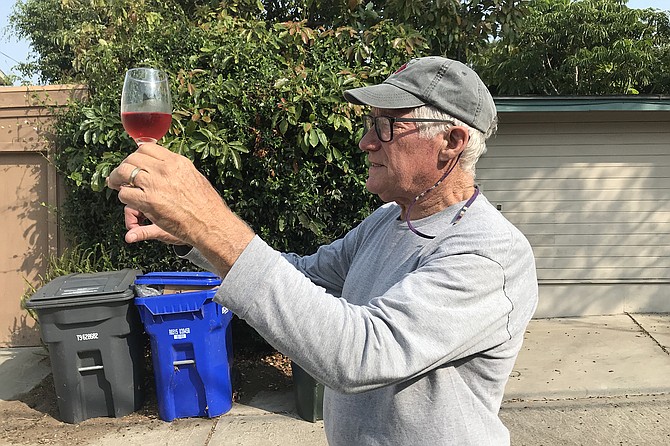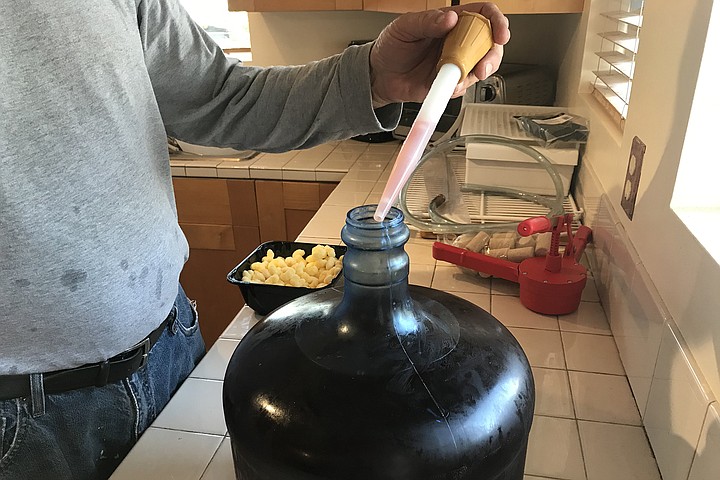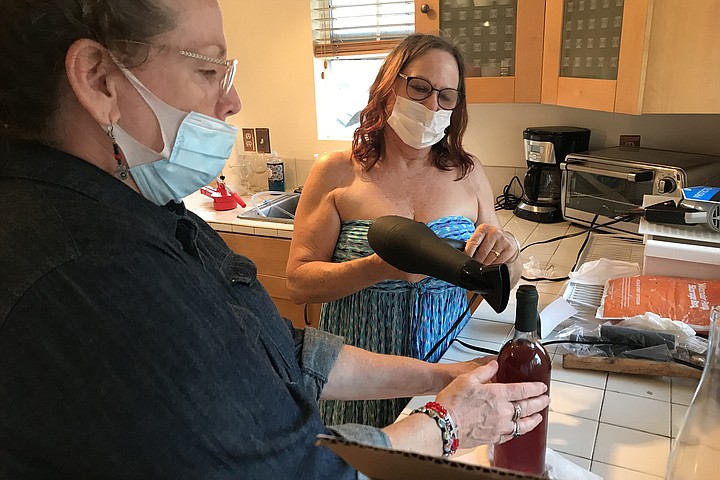 Facebook
Facebook
 X
X
 Instagram
Instagram
 TikTok
TikTok
 Youtube
Youtube

The moment is almost here. It’s a month since my friend Kim and I plucked his garage roof of grapes, pressed, cleared the must and leaves from his “King’s ruby” grapes, and then stirred, and waited, and stirred again, almost daily. (See Golden Dreams, August 19th).
But today, I get the excited call. “You ready to rack and roll?”
“You mean it’s ready?”
“Hey bro, it’s almost clear! It looks like wine. Deep rosé. I got empty bottles and corks from Ballast Point! Wanna come over? Let’s get cracking. It’s time for racking!”

Hey hey! Been waiting for this day. Half an hour later, I’m in his kitchen with my stepdaughter Maggie and Kim’s wife Pam. Turns out “racking” means transferring the wine into bottles.
We haul out the carboy from the fridge, and Kim starts siphoning the wine into a big open bucket. “Why siphon?” I ask. “Because it’s less disruptive to the wine,” he says. We stick the bucket in the kitchen sink, grab a glass, and start pouring the pink stuff through a funnel into fresh bottles.
Twelve bottles later, we have enough left for one more. Kim brings out a really classy bouteille. “This will be for us,” he says, “to celebrate. Vintage of 2020!”

He pours the ruby liquid into four glasses. We stand around like doctors who’ve just delivered a baby. “To the grapes,” intones Kim.
Wow. To my mouth, it tastes fruity, but it’s not sweety-sweet as you might expect from a completely fresh batch of rosé. It’s got a surprisingly mature finish.
Kim agrees. “It shows character that you might taste in full-bodied wines like a cabernet or a merlot. And it’s mellowing out as we speak. The last time I tasted it, it had an almost hoppy bitterness to it. Now that’s all gone. And there were some transitory not-so- pleasant fragrances, but now they’re all gone too. So the wine is continuing its maturation process. I have made wine from these grapes before. Three batches. And I’ll tell you, this is the best I have made. By far.”

“How come?” I ask.
“How to explain? Those grapes just want the wine to taste like this. My theory about winemaking is don’t get in the way of the natural process. Eighty percent of the time, you let the wine make itself.”
Is this his own philosophy?
“It’s my grandfather’s. He was a winemaker all his life. He came from Spain, and he was hired to be a viticulturalist for a French winery called Barré, because he spoke French. But not English. The only English I heard him say was ‘You let the wine make itself, Goddammit.’”
Kim’s calling this wine “Perica Niña,” because a baby green parrot came and landed next to Pam the other day while we were harvesting.
He holds his glass up again and recites:
God gave us the gift of grapes
To cheer both great and small
Little fools will drink too much
And great fools not at all.
“Who said that?” I ask.
“Uh, Dave the Wine Merchant,” he says.


The moment is almost here. It’s a month since my friend Kim and I plucked his garage roof of grapes, pressed, cleared the must and leaves from his “King’s ruby” grapes, and then stirred, and waited, and stirred again, almost daily. (See Golden Dreams, August 19th).
But today, I get the excited call. “You ready to rack and roll?”
“You mean it’s ready?”
“Hey bro, it’s almost clear! It looks like wine. Deep rosé. I got empty bottles and corks from Ballast Point! Wanna come over? Let’s get cracking. It’s time for racking!”

Hey hey! Been waiting for this day. Half an hour later, I’m in his kitchen with my stepdaughter Maggie and Kim’s wife Pam. Turns out “racking” means transferring the wine into bottles.
We haul out the carboy from the fridge, and Kim starts siphoning the wine into a big open bucket. “Why siphon?” I ask. “Because it’s less disruptive to the wine,” he says. We stick the bucket in the kitchen sink, grab a glass, and start pouring the pink stuff through a funnel into fresh bottles.
Twelve bottles later, we have enough left for one more. Kim brings out a really classy bouteille. “This will be for us,” he says, “to celebrate. Vintage of 2020!”

He pours the ruby liquid into four glasses. We stand around like doctors who’ve just delivered a baby. “To the grapes,” intones Kim.
Wow. To my mouth, it tastes fruity, but it’s not sweety-sweet as you might expect from a completely fresh batch of rosé. It’s got a surprisingly mature finish.
Kim agrees. “It shows character that you might taste in full-bodied wines like a cabernet or a merlot. And it’s mellowing out as we speak. The last time I tasted it, it had an almost hoppy bitterness to it. Now that’s all gone. And there were some transitory not-so- pleasant fragrances, but now they’re all gone too. So the wine is continuing its maturation process. I have made wine from these grapes before. Three batches. And I’ll tell you, this is the best I have made. By far.”

“How come?” I ask.
“How to explain? Those grapes just want the wine to taste like this. My theory about winemaking is don’t get in the way of the natural process. Eighty percent of the time, you let the wine make itself.”
Is this his own philosophy?
“It’s my grandfather’s. He was a winemaker all his life. He came from Spain, and he was hired to be a viticulturalist for a French winery called Barré, because he spoke French. But not English. The only English I heard him say was ‘You let the wine make itself, Goddammit.’”
Kim’s calling this wine “Perica Niña,” because a baby green parrot came and landed next to Pam the other day while we were harvesting.
He holds his glass up again and recites:
God gave us the gift of grapes
To cheer both great and small
Little fools will drink too much
And great fools not at all.
“Who said that?” I ask.
“Uh, Dave the Wine Merchant,” he says.
Comments